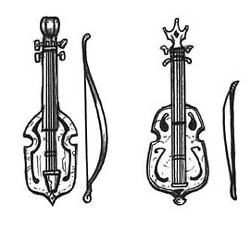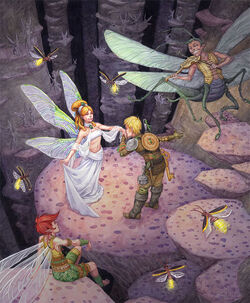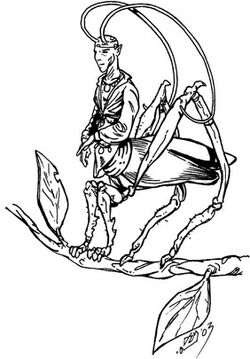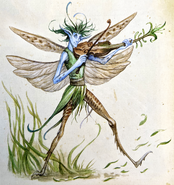Grigs were a fey race and a type of sprite, notable for having the lower bodies of crickets and for having an uncanny talent at playing a fiddle. They were mischievous fey who were fond of playing harmless pranks on "big people".[5][4][6][2][1]
Description[]
On average, these small sprites grew to be about 1.5 feet (46 centimeters) tall and weighed only 1 pound (450 grams). They had the head, arms, and torso of a normal sprite, with light blue skin and forest-green hair, as well as antennae. However, from the waist down, grigs had a brown, cricket-like body including a pair of gossamer wings and hairy legs. Grigs typically wore brightly colored tunics or vests with tiny gems for buttons.[4][2]
Like a male cricket, grigs could emit chirps by rubbing a ridged vein on their forewings against the hardened underside of their top wings, similar to the bow of a fiddle against its string.[1]
Personality[]
Grigs were typically shy around strangers[5] and cautious, but ultimately trusting[4] and overall good-natured and friendly.[5][6] They were content to pass their time frolicking in idyllic meadows.[6]
They were also lighthearted and loved to engage in mischief and pranks, especially against larger creatures—from their perspective, just about everybody.[5][4][6][2][3][1] Classic "pranks" included thieving food and items, causing tents to collapse, making items appear to talk with their ventriloquism, gluing swords into their scabbards, scribbling rude images in the margins of spellbooks, rearranging furniture and even attaching it to the walls or ceilings, daubing sticky sap on things, putting holes in flagons, and chirping like true crickets to stir people trying to sleep.[4][2][1] They usually loitered nearby to observe the outcome and have a good laugh.[4][1] These were not intended to be cruel, however. To a grig, mischief was life. Opposing them would only amuse them and drive them to greater efforts. The only effective way of dealing with a grig was to be patient and not give it the reactions it was looking for, so it would quickly grow bored and go elsewhere.[1] Otherwise, once they'd had their fill of fun[4] or if they'd gone too far and caused genuine offense or grief,[1] the grig would make amends with a small gift: a valuable jar of fresh honey or a gem or trinket,[4][1] possibly originating from Faerie or the Feywild.[1]
With no desire for violence, they avoided fights at all costs, even apologizing if they must. Despite this, they would defend themselves if forced,[1] against wicked creatures and those who attacked grigs.[5] They were fierce fighters who were afraid of no-one, no matter how big.[2][1]
Among all the sprites, grigs were the most energetic, being constantly on the move in search of activity and adventure and never resting. They slept for but a few seconds at a time, usually when feywine got the better of them. They played their music through the night to entertain and to annoy others.[1]
Abilities[]
Like a bard, grigs could weave magic from their music.[1] Whenever a grig played a fiddle, they could compel any and all creatures within 30 feet (9.1 meters) to dance uncontrollably, similarly to the effects of Otto's irresistible dance. Grigs and other sprites were immune to this effect and one grig could play for hours without tiring, though the same could not be said of those forced to dance for as long as they played—victims could well collapse in exhaustion ere that happened.[5][4][2][1] After the Spellplague, this was reduced to 15 feet (4.6 meters) and the forced dancing slowed and distracted those affected.[1] And naturally, they were excellent players[2] with an innate talent for music and the ability to compose tunes on the fly. One theory went that a grig's skill with the fiddle was because it functioned the same way their wings did when chirping. They could also make chirps of different notes and pitches to add a second "instrument" as a counterpoint to their fiddling.[1]
Like many fey, grigs possessed other innate magical powers that they used to both protect themselves and play practical jokes on others. These replicated the spells disguise self, entangle, invisibility (only themselves), pyrotechnics, trip, and ventriloquism.[5][4][2]
These fey could see in low-light conditions,[2][1] the infrared spectrum,[4] or the ultraviolet spectrum.[5] Their visual range with the latter two senses was up to 180 feet (55 meters). In addition, their hearing was twice as good as any human's. Altogether this made it very difficult to sneak up on them.[5][4]
Thanks to their cricket legs and wings, grigs could jump vast distances, at least for their size. They were also adept at moving stealthily, especially in a forest setting.[5][4][2][1]
Possessions[]

Left: a regular grig fiddle and (right) a master fiddle.
In any band of grigs, one would carry a fiddle, sized for them.[4][2] They never went anywhere without one.[4] It took a day for a grig fiddler to attune a mundane fiddle to itself and its magic so it could create the irresistible dance effect. It would work for no other creature and would lose its attunement after a week away from its grig owner.[3] However, they could fashion grig fiddles that would work for others, at least those of the same size. Master fiddles were exquisite instruments capable of producing the most beautiful music, and granted grigs many of the powers of great bards.[7]
For combat, grigs typically wielded a half-dozen darts and tiny needle-like daggers and swords,[5][4] longbows and short swords,[2] or daggers alone.[1] These variations may be due to the special knack they had with their weapons: accounting for size, a grig dagger was as good as a short sword in their hands, but no more than a knife in another's.[5][4]
Tactics[]
Making up for their small size and weakness, they preferred to fight with clever tactics, ranged weaponry and magic, ambushes, and subterfuge, rather than in a face-to-ankle fight.[2][3] They would throw their darts at creatures while in a hopping flight or leap and poke their foe with their blades in a nimble attack.[5][4][1] Making up for their size, they were deadly accurate and quick, always jumping from place to place and with endless energy. They would also use their invisibility to fade out of sight before making a surprise attack.[1]
Society[]
Grigs lived in temperate forests,[2] specifically within glens, meadows, and woodlands.[5][6] They didn't make any permanent dwellings, but regularly slept in the branches of treants or close to unicorns[4] or made cozy little hollows in the sides of low hills.[6]
They tended to sleep during the day and go out at night to forage for food, dance, and play.[5][4][6] They were herbivorous, preferring to eat nuts, berries, and honey,[4] but their favorite food was mushroom.[6]
They usually roamed in gangs of up to four or in bands of up to eleven or twelve. Tribes of grigs numbered twenty to eighty.[5][4][2]

A grig fiddler playing for a pixie, sylph, and brownie, surrounded by fireflies.
Among other fey in the plane of Faerie, grigs served as minstrels and bards. They played music and leaped and danced to entertain at fey festivals. Other fey appreciated this, for it kept the grigs busy and out of mischief. Grigs were said by others to be the most talented fiddle players in all of Faerie, and by grigs themselves to be the most talented anywhere,[1] though others claimed leprechauns alone were better.[6]
Grigs had their own deity, who was likely part of the Seelie Court.[8]
Homelands[]
In central and north Faerûn, grigs were found in the midwood area of Cormanthor,[9] and more generally in the forests of Cormyr, Sembia, and the Dalelands,[10] and in the Border Forest.[11] In west Faerûn, they could be found in the Cloak Wood.[12] In south Faerûn, they might be found in the Forest of Amtar.[13] In the east Faerûn, grigs could be found in the Forest of Lethyr and the Yuirwood.[14] In earlier times, they lived within the city dump of Cursrah and helped exterminate rats.[15]
Beyond Toril, grigs were known to exist on the planet of Oerth.[16]
Relationships[]
Grig bands and atomie tribes were known to often gather together[5][4][6] at night under the light of the moon. Altogether, there could be up to 50 grigs and 120 atomies at such gatherings. There they would, play, perform circle dances, and engage in a variety of pastimes, while some grigs would play their bowed string instruments.[5]
The archfey and celestial eladrin of the Court of Stars had grig musicians to entertain at their events.[1] Grigs were known to serve the deities Erevan Ilesere and Rillifane Rallathil of the elven pantheon[17] and Sheela Peryroyl of the halfling pantheon.[18]
Unicorns would fight to the death to protect grigs.[4]
Grigs occasionally befriended elves and others who respected the forest, and might even join a like-minded adventuring company, at least one that would tolerate them.[3]
Languages[]
Grigs spoke Sylvan[4][2] and possibly Common[2][1] or Elven.[1] They particularly knew the Sylvan dialects of the atomies, brownies, pixies, and sprites, as well as the grig dialect. Whenever they spoke in Common, a grig had to slow their speech and pitch downward in scale.[5]
History[]
How grigs came to be, and how they got their legs, was shrouded in mystery.[4][6] In some beliefs, they made some transgression against Rhiannon, Queen of the Faeries, and she punished them with cricket legs, though others held she simply made them that way out of a sense of humor. Others theorized grigs weren't really faeries at all, but were the result of a wizard's experimentations. Those who asked the grigs themselves found they did not seem to know, and did not really care.[6]
In Cormanthor's western starwood in the Year of the Shield, 1367 DR, a band of grigs stole the eggs of a female cockatrice while it was away hunting, as a so-called practical joke. Thereafter, the despairing cockatrice screamed incessantly from its oak hollow nest. Disturbed by the noise, a local elf family sought adventurers who could get the eggs back from the grigs or else put down the cockatrice.[19]
Notable Grigs[]

Groef Feythrin, a prince among grigs.
- Feythrin, a grig prince of the southern High Forest.[20]
- Ikiiki Ikiiki, a grig who worked as a nightclub musician at the For-Rest Inn in Ravens Bluff.[21]
Appendix[]
Gallery[]
Appearances[]
Adventures
Novels & Short Stories
Star of Cursrah
Video Games
Organized Play & Licensed Adventures
References[]
- ↑ 1.00 1.01 1.02 1.03 1.04 1.05 1.06 1.07 1.08 1.09 1.10 1.11 1.12 1.13 1.14 1.15 1.16 1.17 1.18 1.19 1.20 1.21 1.22 1.23 1.24 1.25 1.26 1.27 1.28 1.29 1.30 1.31 Steve Townshend (February 2013). “The Dragon's Bestiary: Fey of Wood and Wind”. In Steve Winter ed. Dragon #420 (Wizards of the Coast), pp. 7–8.
- ↑ 2.00 2.01 2.02 2.03 2.04 2.05 2.06 2.07 2.08 2.09 2.10 2.11 2.12 2.13 2.14 2.15 2.16 2.17 2.18 2.19 2.20 2.21 2.22 2.23 2.24 2.25 2.26 Skip Williams, Jonathan Tweet, Monte Cook (July 2003). Monster Manual v.3.5. (Wizards of the Coast), p. 235. ISBN 0-7869-2893-X.
- ↑ 3.0 3.1 3.2 3.3 3.4 Jennifer Clarke Wilkes, David Eckelberry, Rich Redman (February 2003). Savage Species. (Wizards of the Coast), pp. 175–176. ISBN 0-7869-2648-1.
- ↑ 4.00 4.01 4.02 4.03 4.04 4.05 4.06 4.07 4.08 4.09 4.10 4.11 4.12 4.13 4.14 4.15 4.16 4.17 4.18 4.19 4.20 4.21 4.22 4.23 4.24 4.25 4.26 4.27 4.28 4.29 4.30 4.31 4.32 4.33 4.34 4.35 4.36 4.37 Doug Stewart (June 1993). Monstrous Manual. (TSR, Inc), pp. 328, 330. ISBN 1-5607-6619-0.
- ↑ 5.00 5.01 5.02 5.03 5.04 5.05 5.06 5.07 5.08 5.09 5.10 5.11 5.12 5.13 5.14 5.15 5.16 5.17 5.18 5.19 5.20 5.21 5.22 5.23 5.24 5.25 5.26 Gary Gygax (August 1983). Monster Manual II 1st edition. (TSR, Inc), pp. 11, 71. ISBN 0-88038-031-4.
- ↑ 6.00 6.01 6.02 6.03 6.04 6.05 6.06 6.07 6.08 6.09 6.10 6.11 6.12 6.13 Vince Garcia (March 1990). “The Folk of the Faerie Kingdom”. In Roger E. Moore ed. Dragon #155 (TSR, Inc.), p. 34.
- ↑ Jennifer Clarke Wilkes, David Eckelberry, Rich Redman (February 2003). Savage Species. (Wizards of the Coast), pp. 57–58. ISBN 0-7869-2648-1.
- ↑ Eric L. Boyd (November 1998). Demihuman Deities. Edited by Julia Martin. (TSR, Inc.), p. 92. ISBN 0-7869-1239-1.
- ↑ James Butler, Elizabeth T. Danforth, Jean Rabe (September 1994). “Explorer's Manual”. In Karen S. Boomgarden ed. Elminster's Ecologies (TSR, Inc), p. 10. ISBN 1-5607-6917-3.
- ↑ James Butler, Elizabeth T. Danforth, Jean Rabe (September 1994). “Cormanthor”. In Karen S. Boomgarden ed. Elminster's Ecologies (TSR, Inc), p. 31. ISBN 1-5607-6917-3.
- ↑ Ed Greenwood, Sean K. Reynolds, Skip Williams, Rob Heinsoo (June 2001). Forgotten Realms Campaign Setting 3rd edition. (Wizards of the Coast), p. 127. ISBN 0-7869-1836-5.
- ↑ Ed Greenwood, Julia Martin, Jeff Grubb (1993). Forgotten Realms Campaign Setting 2nd edition (revised), A Grand Tour of the Realms. (TSR, Inc), p. 90. ISBN 1-5607-6617-4.
- ↑ Thomas Reid (October 2004). Shining South. (Wizards of the Coast), p. 84. ISBN 0-7869-3492-1.
- ↑ Richard Baker, Matt Forbeck, Sean K. Reynolds (May 2003). Unapproachable East. (Wizards of the Coast), pp. 90, 94. ISBN 0-7869-2881-6.
- ↑ Clayton Emery (January 1999). Star of Cursrah. (Wizards of the Coast), p. 70. ISBN 0-7869-1322-3.
- ↑ Grant Boucher, William W. Connors, Steve Gilbert, Bruce Nesmith, Christopher Mortika, Skip Williams (April 1990). Monstrous Compendium Greyhawk Adventures Appendix. Edited by Mike Breault. (TSR, Inc.), p. 51. ISBN 0-88038-836-6.
- ↑ Eric L. Boyd (November 1998). Demihuman Deities. Edited by Julia Martin. (TSR, Inc.), pp. 109, 122. ISBN 0-7869-1239-1.
- ↑ Eric L. Boyd (November 1998). Demihuman Deities. Edited by Julia Martin. (TSR, Inc.), p. 172. ISBN 0-7869-1239-1.
- ↑ James Butler, Elizabeth T. Danforth, Jean Rabe (September 1994). “Cormanthor”. In Karen S. Boomgarden ed. Elminster's Ecologies (TSR, Inc), p. 32. ISBN 1-5607-6917-3.
- ↑ Stephen Radney-MacFarland (2003). Legacy of the Green Regent: Extermination. (Wizards of the Coast), p. 7.
- ↑ Mike Selinker (September 1989). “The Living City: The For-Rest Inn”. In Jean Rabe ed. Polyhedron #49 (TSR, Inc.), p. 29.


